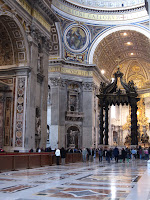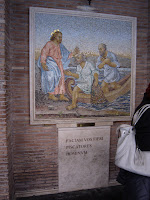




Our final day in Rome began with a trip to the Vatican. The Basilica of Saint Peter is built on the site believed to hold Peter's tomb. A church was built here by Constantine in AD 319, replaced by St. Peter's in the 16th century.







The interior is unbelievably large. The central aisle has, inscribed in the marble floor, the names of the world's greatest cathedrals, listed by size. The message is clear: St. Peter's tops the list. At the center, above the papal altar, stands Bernini's baldacchino (canopy). Though he has been suspected of using bronze melted down from the Pantheon's portico, he's since been acquitted by historians.





Before the front right support for the dome sits a bronze statue of Peter. Worshippers touch his right foot, wearing down the metal; it's completely smooth now. Michelangelo's Pieta sits in a chapel just to the right of the entrance. The legend states that the 24-year-old overheard other artists being given credit for his work, so he entered the basilica at night and carved his name into the ribbon across Mary's chest. A replica in the Vatican Museums allowed us a closer view.






In the museums were many wonder statues and tapestries. Large sections were dedicated to Egyptian and Etruscan artifacts. However, the buildings' frescoes were the main attractions.


Raphael painted several rooms in the rear of the complex. The Room of Constantine was devoted to events in the life of the first Christian emperor.


The Room of Heliodorus depicts several moments, Biblical and later, of divine protection for the church.


The Room of the Segnatura contains some of Raphael's most famous frescoes. Supernatural truth is depicted in Disputation of the Most Holy Sacrament, while rational truth is depicted in School of Athens.

The Room of the Fire in the Borgo shows events from the lives of Popes Leo III and Leo IV.




But of course, Michelangelo's Sistine Chapel tops all other sights. The chapel is not particularly large. We were packed in somewhat tight with other tourists, craning our necks upward to admire the works. Along the side walls, lunettes depict the lineage of Christ. Pontifs appear below, followed by scenes from the life of the Savior. Along the back wall is The Last Judgement. Michelangelo broke several traditions in his depiction of the event, but the most egregious was the ubiquitous nudity. After his death, cloths were painted into the scene to cover the objectionable portions. The ceiling has nine panels, with three panels each devoted to the creation of the world, the creation and fall of man, and the great flood.




After the Vatican Museums, we took in a late lunch, and then visited Piazza del Popolo. Three long, straight streets converge here, allowing you to look across most of Rome from one location. The obelisk from the Circus Maximus that I mentioned earlier towers over the large, open piazza.





We headed down the left of the three streets, and arrived at the Spanish Steps. Had we visited a month later, the stairs would have been lined with azaleas. Around the corner from the top of the steps, we saw that Palazetto Zuccari was having some work done, but we didn't let that stop us from doing our best impressions.

1 comment:
Outstanding quest there. What happened after? Thanks!
Also visit my weblog - Healthy diet plans
Post a Comment